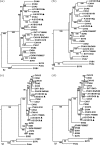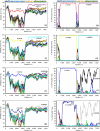Complete genome analysis of coxsackievirus A2, A4, A5, and A10 strains isolated from hand, foot, and mouth disease patients in China revealing frequent recombination of human enterovirus A
- PMID: 21543560
- PMCID: PMC3147834
- DOI: 10.1128/JCM.00007-11
Complete genome analysis of coxsackievirus A2, A4, A5, and A10 strains isolated from hand, foot, and mouth disease patients in China revealing frequent recombination of human enterovirus A
Abstract
Coxsackievirus (CV) strains CVA2, CVA4, CVA5, and CVA10 were isolated from patients with hand, foot, and mouth disease during a 2009 outbreak in China. Full genome sequences for four representative strains, CVA2/SD/CHN/09 (A2SD09), CVA4/SZ/CHN/09 (A4SZ09), CVA5/SD/CHN/09 (A5SD09), and CVA10/SD/CHN/09 (A10SD09), were determined. Phylogenetic and recombination analyses of the isolates by comparison with human enterovirus A prototype strains revealed that genetic recombination occurred during cocirculation of the viruses. The A2SD09 and A4SZ09 strains were most closely related to their corresponding prototype strains in the capsid region but shared noncapsid sequences with each other. Similarly, strains A5SD09 and A10SD09 had serotype-specific homology for the capsid proteins but shared noncapsid sequences with each other. Phylogenetic analyses of the four isolates with homotypic strains showed that CVA2 strains were divided into five genotypes. The A2SD09 strain clustered with Mongolia strains isolated in 2003, forming genotype V. The A4SZ09 strain and other isolates from mainland China and Taiwan clustered with genotype III strains and are likely related to strains that circulated in Europe and Mongolia. The A5SD09 strain is closely related to other Chinese strains isolated in 2008. The A10SD09 isolate, together with other Chinese strains isolated since 2004, formed a distinct lineage that was likely imported from Japan and South Korea. This study shows that natural recombination is a frequent event in human enterovirus A evolution. More comprehensive surveillance of enteroviruses that focus not only on EV71 or CVA16 is needed for us to understand the molecular epidemiology of enteroviruses and to track recombination events which may ultimately affect the virulence of viruses during outbreaks.
Figures



Similar articles
-
Epidemiological and etiological characteristics of hand, foot, and mouth disease in Wuhan, China from 2012 to 2013: outbreaks of coxsackieviruses A10.J Med Virol. 2015 Jun;87(6):954-60. doi: 10.1002/jmv.24151. Epub 2015 Mar 9. J Med Virol. 2015. PMID: 25754274
-
Co-circulation and genomic recombination of coxsackievirus A16 and enterovirus 71 during a large outbreak of hand, foot, and mouth disease in Central China.PLoS One. 2014 Apr 28;9(4):e96051. doi: 10.1371/journal.pone.0096051. eCollection 2014. PLoS One. 2014. PMID: 24776922 Free PMC article.
-
Molecular epidemiology and recombination of Enterovirus A71 in mainland China from 1987 to 2017.Int Microbiol. 2021 Aug;24(3):291-299. doi: 10.1007/s10123-021-00164-2. Epub 2021 Feb 19. Int Microbiol. 2021. PMID: 33608776 Free PMC article.
-
Human enterovirus 71 epidemics: what's next?Emerg Health Threats J. 2013 Sep 10;6:19780. doi: 10.3402/ehtj.v6i0.19780. Emerg Health Threats J. 2013. PMID: 24119538 Free PMC article. Review.
-
The Growing Phenomenon of 'Frozen' Virus Genome Sequences and Their Likely Origin in Research Facility Escapes.Microorganisms. 2024 Nov 24;12(12):2412. doi: 10.3390/microorganisms12122412. Microorganisms. 2024. PMID: 39770614 Free PMC article. Review.
Cited by
-
Simultaneously typing nine serotypes of enteroviruses associated with hand, foot, and mouth disease by a GeXP analyzer-based multiplex reverse transcription-PCR assay.J Clin Microbiol. 2012 Feb;50(2):288-93. doi: 10.1128/JCM.05828-11. Epub 2011 Nov 23. J Clin Microbiol. 2012. PMID: 22116146 Free PMC article.
-
A novel recombinant lineage's contribution to the outbreak of coxsackievirus A6-associated hand, foot and mouth disease in Shanghai, China, 2012-2013.Sci Rep. 2015 Jun 30;5:11700. doi: 10.1038/srep11700. Sci Rep. 2015. PMID: 26121916 Free PMC article.
-
Recombination of human coxsackievirus B5 in hand, foot, and mouth disease patients, China.Emerg Infect Dis. 2012 Feb;18(2):351-3. doi: 10.3201/eid1802.111524. Emerg Infect Dis. 2012. PMID: 22305307 Free PMC article. No abstract available.
-
Genomic surveillance of coxsackievirus A10 reveals genetic features and recent appearance of genogroup D in Shanghai, China, 2016-2020.Virol Sin. 2022 Apr;37(2):177-186. doi: 10.1016/j.virs.2022.01.028. Epub 2022 Jan 24. Virol Sin. 2022. PMID: 35234621 Free PMC article.
-
Prevalence of multiple enteroviruses associated with hand, foot, and mouth disease in Shijiazhuang City, Hebei province, China: outbreaks of coxsackieviruses a10 and b3.PLoS One. 2014 Jan 2;9(1):e84233. doi: 10.1371/journal.pone.0084233. eCollection 2014. PLoS One. 2014. PMID: 24392117 Free PMC article.
References
-
- Ang L. W., et al. 2009. Epidemiology and control of hand, foot and mouth disease in Singapore, 2001-2007. Ann. Acad. Med. Singapore 38:106–112 - PubMed
-
- Blomqvist S., et al. 2010. Co-circulation of coxsackieviruses A6 and A10 in hand, foot and mouth disease outbreak in Finland. J. Clin. Virol. 48:49–54 - PubMed
-
- Caro V., Guillot S., Delpeyroux F., Crainic R. 2001. Molecular strategy for ‘serotyping' of human enteroviruses. J. Gen. Virol. 82:79–91 - PubMed
-
- Casas I., et al. 2001. Molecular characterization of human enteroviruses in clinical samples: comparison between VP2, VP1, and RNA polymerase regions using RT nested PCR assays and direct sequencing of products. J. Med. Virol. 65:138–148 - PubMed
Publication types
MeSH terms
Substances
Associated data
- Actions
- Actions
- Actions
- Actions
LinkOut - more resources
Full Text Sources
Other Literature Sources

